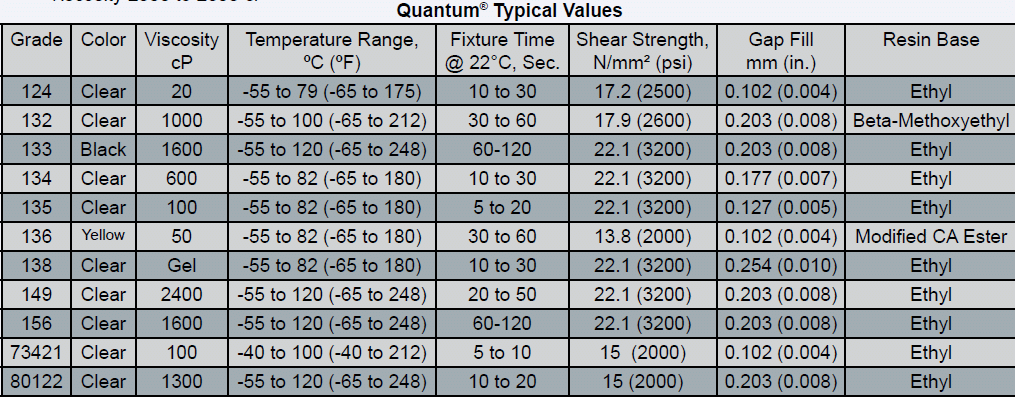top of page
100 - Instant Adhesives
Series 100

Bonding
Hernon offers a very complete selection of cyanoacrylate adhesives. Two different categories are offered: Instantbond & Quantum. The Instantbond grades offer "classic" performance, while the Quantum grades deliver "special" or "advanced" performance. The differences between the two categories are the result of formulation, modification and molecular engineering.
Instantbond Cyanoacrylates
Classic cyanoacrylates are represented by the ethyl and methyl chemistries. Generally, the methyls offer better bond strengths on metals, the ethyls providing better strengths on everything else. Substrate selection and bondline configuration directly influence adhesive performance.
Instantbond grades cure as the result of contact with trace amounts of moisture. The reaction is called ionic polymerization. Any surface capable of absorbing moisture is a good surface for bonding.

QUANTUM
The Quantum® group of cyanoacrylates offers
specialized performance attributes. This range of grades
has been engineered to provide solutions to specific
cyanoacrylate challenges. Three categories are offered:
surface insensitive, toughened and low odor / low blooming.
These products have specially modified formulations to
eliminate vapor transmissions and adhesive residue that
can settle on parts during curing and can therefore be
used in poorly ventilated assemblies.
Surface insensitive grades function in
environments hostile to the “classic” cyanoacrylates.
These formulations will bond acidic, freshly plated,
leather and wooden surfaces. Plastic and rubber parts
not bondable with “regular” cyanoacrylates are bonded
with surface insensitive types. Porous materials also
respond well to this category of adhesives. The Quantum
family is the best choice for bonding composite and exotic
combinations of materials. Atmospheric moisture can be
near zero when working with these products


Cyanoacrylate modify fast bonding adhesive formulated for extreme conditions
HERNON QUANTUM 156
Cyanoacrylate ethyl base with liquified synthetic rubb
for bonding metal , plastics and elastomer applications facing impact, thermal shock and peel resistance
up to 121 C

POLYOLEFIN'S BONDING
HERNON new formula for bonding hard to bond polymers such as Polypropylene , High density Polyurethane -PEX
Polyolefin polymer is considered as a preferably raw material , cost effective and highly used in the water , food and Gas industry
Polyolefin distinctive advantage is the polymer chemical indifference for wide range of ingredients he face in harsh work environment he design to meet
Polyolefin Downside follows his advantage, meaning bonding and sealing such indifference material is an industrial challenge.
There for, when arrives a need to "bond " polyolefins, Ultrasonic welding is the preferably method, Unfortunately the downside of this technology is when a face to face section is needed to be bonded and seal - that's where it fails .
The HERNON new cyanoacrylate formula design to give solution
HERNON 73241 Low viscosity – 150 CPS -close fit
bonding up to 0.15 mm gap
HERNON 80122 - medium viscosity - 2000 cps - for larger gaps up to 0.25 mm
bottom of page

